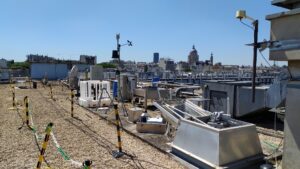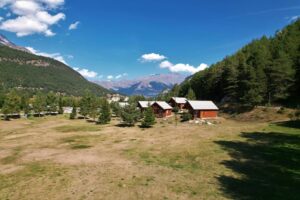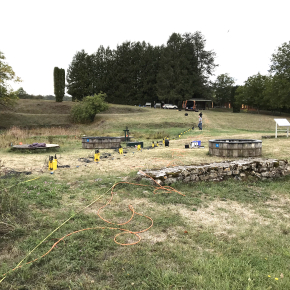CDD
Proposed thesis topic for the start of the 2024 academic year – Observation and characterization of thunderstorm dynamics using a tandem of satellites
Context
ÉCOLE DOCTORALE DES SCIENCES DE L’ENVIRONNEMENT D’ILE DE France N°129
Proposed thesis topic for the start of the 2024 academic year
Name of host laboratory : LSCE
N° UMR : 8212
Name of Laboratory Director : Philippe BOUSQUET
Full address of laboratory : L’Orme des Merisiers, CEA Saclay, Chemin de St Aubin – RD 128,
F-91191 Gif-sur-Yvette Cedex
Name of thesis supervisor HDR : Hélène Brogniez
Phone : 01 69 08 96 04
Mail :
Name of HDR co-supervisor : Frédéric Chevallier
Mail :
Thesis title :
Observation and characterization of thunderstorm dynamics using a tandem of satellites
Thunderstorm are produced by atmospheric convection: mid-latitude storms and tropical cyclones and
thunderstorms produce extreme weather conditions, while the precipitation (rain or snow) produced helps to feed these cloud systems, due to the heating of the ambient air. However, while the convective principle itself is well understood thanks to the laws of physics, the factors triggering the formation of a thunderstorm, those driving its evolution (growth, maturity, dissipation) and the implications for the thunderstorm’s immediate environment (atmosphere and surface) still face a number of hurdles. These are mainly associated with the internal dynamic structure of thunderstorms, and constitute the current limits of their representation in numerical weather simulation tools. Thus, progress in forecasting thunderstorm weather events requires major advances in our understanding of transport within thunderstorms. These advances will also be key to understanding and better forecasting the evolution of thunderstorms in a changing climate.
Description
This PhD project is part of the scientific and industrial analyses carried out as part of the CNES observation
project called “C²OMODO”. C²OMODO is based on the use of measurements from a small tandem of satellites, about 2 minutes apart, carrying identical radiometers measuring radiation emitted in the microwave range: the short time lag between two measurements will enable us to characterize the vertical movement of icy particles forming within the great ascents of thunderstorms. Measurements with such a slight time lag will give access to the mass fluxes of these particles at each observation point, while the swath of instruments (passive remote sensing) will provide the horizontal dimensions of the various parts making up the thunderstorms observed.
The C²OMODO observation system is part of CNES’s contribution to the AOS (“Atmosphere Observing
System” https://aos.gsfc.nasa.gov/) program, led by NASA in collaboration with other major space agencies (CNES, JAXA, CSA) and scheduled for 2027-2030. The AOS constellation will comprise satellites carrying lidars, radars, radiometers, polarimeters and stereo cameras, organized on two orbital planes. Within this constellation, C²OMODO directly targets deep convection, its vertical development and life cycle.
Work carried out by the C2OMODO scientific team in collaboration with CNES has already highlighted the
information content of this tandem (Brogniez et al, 2022). However, the so-called “proof-of-concept”
demonstrations have been carried out using more or less idealized atmospheric simulations and an observable simulator, since this work is being carried out prior to launch. Algorithmic methods, of the variational and supervised classification type, are currently being developed to define the geophysical quantities that will be exploited and delivered to the international scientific community.
An innovative 1D variational approach (1D-VAR), developed thanks to the expertise of LSCE (e.g. Chevallier
et al., 2002), is used to invert slightly time-displaced measurements (small dt) into physical variables of ice
production and vertical displacement of this ice in the convective column of the cloud. These two parameters can be used to describe, in the first instance, the growth of a thunderstorm. However, rather strong assumptions have been made, notably concerning the cloud’s ice mass balance (microphysical processes are ignored), or concerning horizontal dynamics and the cloud’s immediate environment, which do play a role in vertical development. Thus, this PhD project aims to improve the existing 1D-VAR approach by refining the initial hypotheses using measurements of convective activity (ice content, vertical distribution, speed of movement of icy hydrometeors, etc.) collected during various field campaigns (radar measurements, lidar, aircraft flights, etc.). Hence, the PhD candidate will :
- Analyze measurements collected during various observation campaigns carried out in tropical regions and mid-latitudes (e.g. CADDIWA campaign, 2021, Flamant et al, 2021) and describing the icy part of convection, and compare the assumptions of the 1D-VAR inversion scheme with these field observations ;
- Adjust the parameters of the inversion method to the observations collected (satellite, in-situ,
airborne) and to carry out sensitivity tests on certain parameters of the tandem (such as the time difference between the 2 instruments). To this end, the PhD student will manipulate high-spatial-resolution (~200m) numerical simulations of the corresponding atmosphere produced around these campaigns, notably with the Meso-NH system (Lac et al, 2018) used by the C2OMODO project’s scientific team. These numerical simulations will be coupled to the satellite observables simulator (RTTOV international radiative transfer model, developed by the EUMETSAT agency) and to the tandem simulator developed by CNES, in order to exploit virtual observations close to what will be expected ; - Evaluate the performance on other identified measurement campaigns (currently 3 over the 2024-2026 period) to assess errors and uncertainties.
This work is central to the C2OMODO project, since it involves developing the core algorithm of the
C2OMODO project, with a robust estimate of its performance (conditional bias, uncertainties, etc.),
contributing to the definition of the specific features of the tandem, and defining the requirements of the
campaign to validate the measurements obtained by C2OMODO.
The scientific environment will enable participation in international symposia, and the computing resources
will be those of IPSL.
Bibliography :
– Chevallier F., P. Bauer, JF Mahfouf and JJ Morcrette (2002) Variational retrieval of cloud profile from ATOVS observations. Q. J. R. Meteorol. Soc., doi :10.1256/qj.01.153
– Lac, C., Chaboureau, J.-P., Masson, V., Pinty, J.-P., Tulet, P., Escobar, J., et al. (2018). Overview of the Meso-NH Model Version 5.4 and its Applications. Geosci. Model. Dev. 11, 1929–1969. doi:10.5194/gmd-11-1929-2018
– Flamant C., J. Delanoë, JP Chaboureau, C. Lavaysse, M. Gaetani, et O. Bock (2021) La campagne Caddiwa dans la région des îles du Cap-Vert. La Météorologie, N° 115 (Novembre), doi : 10.37053/lameteorologie-2021-0081
– Brogniez H., R. Roca, F. Auguste, JP Chaboureau, Z. Haddad, S. J. Munchak, X. Li, D. Bouniol, A. Dépée, T. Fiolleau and P. Kollias (2022) Time-delayed tandem microwave observations of tropical deep convection: Overview of the C2OMODO mission. Frontiers in Remote Sensing, doi:10.3389/frsen.2022.854735
Type de financement autre que ED 129, précisez si envisageable ou acquis (CNES, CEA, ADEME etc…) :
Financement CEA acquis.
Encadrement :
Liste des autres doctorants que vous encadrez ou co-encadrez au 1er janvier 2024
Thomas Lefebvre, UVSQ, CNES et Airbus DS, soutenance prévue en septembre/octobre 2025.
Required Skills
M2 degree in geosciences, climatology, meteorology or physical remote sensing methods.
Knowledge of statistical data analysis, inverse methods, scientific programming (python, R, matlab).






